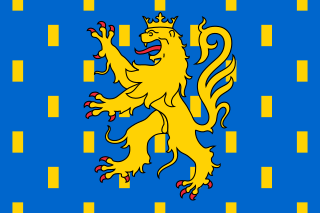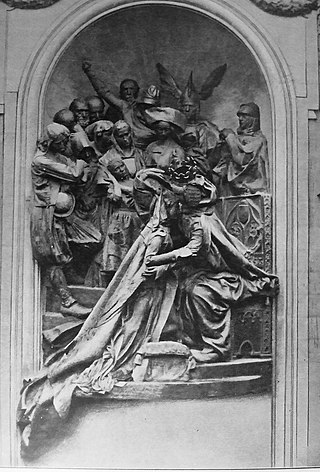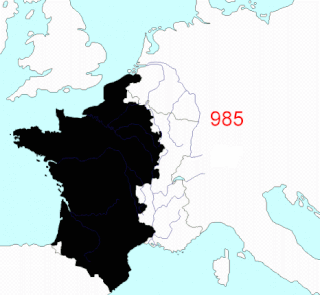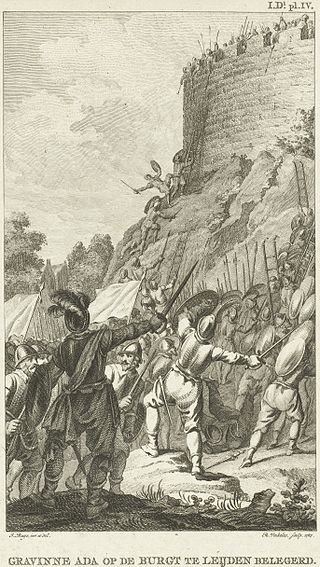
The Duchy of Guelders is a historical duchy, previously county, of the Holy Roman Empire, located in the Low Countries.

The Capetian house of Valois was a cadet branch of the Capetian dynasty. They succeeded the House of Capet to the French throne, and were the royal house of France from 1328 to 1589. Junior members of the family founded cadet branches in Orléans, Anjou, Burgundy, and Alençon.

The Duchy of Saxony was originally the area settled by the Saxons in the late Early Middle Ages, when they were subdued by Charlemagne during the Saxon Wars from 772 and incorporated into the Carolingian Empire (Francia) by 804. Upon the 843 Treaty of Verdun, Saxony was one of the five German stem duchies of East Francia; Duke Henry the Fowler was elected German king in 919.

The Duchy of Brittany was a medieval feudal state that existed between approximately 939 and 1547. Its territory covered the northwestern peninsula of Europe, bordered by the Atlantic Ocean to the west, and the English Channel to the north. It was also less definitively bordered by the river Loire to the south, and Normandy, and other French provinces, to the east. The Duchy was established after the expulsion of Viking armies from the region around 939. The Duchy, in the 10th and 11th centuries, was politically unstable, with the dukes holding only limited power outside their own personal lands. The Duchy had mixed relationships with the neighbouring Duchy of Normandy, sometimes allying itself with Normandy, and at other times, such as the Breton–Norman War, entering into open conflict.

The House of Welf is a European dynasty that has included many German and British monarchs from the 11th to 20th century and Emperor Ivan VI of Russia in the 18th century. The originally Franconian family from the Meuse-Moselle area was closely related to the imperial family of the Carolingians.

The Free County of Burgundy was a medieval feudal state ruled by a count from 982 to 1678. It was also known as Franche-Comté, from French: franc comte meaning 'free count', and was located in the modern region of Franche-Comté. It bordered the Duchy of Burgundy to the west, which was part of France from 843.

The Duchy of Burgundy emerged in the 9th century as one of the successors of the ancient Kingdom of the Burgundians, which after its conquest in 532 had formed a constituent part of the Frankish Empire. Upon the 9th-century partitions, the French remnants of the Burgundian kingdom were reduced to a ducal rank by King Robert II of France in 1004. Robert II's son and heir, King Henry I of France, inherited the duchy but ceded it to his younger brother Robert in 1032.

The Duchy of Aquitaine was a historical fiefdom in western, central, and southern areas of present-day France to the south of the river Loire, although its extent, as well as its name, fluctuated greatly over the centuries, at times comprising much of what is now southwestern France (Gascony) and central France.

Francis II was Duke of Brittany from 1458 to his death. He was the grandson of John IV, Duke of Brittany. A recurring theme in Francis' life would be his quest to maintain the quasi-independence of Brittany from France. As such, his reign was characterized by conflicts with King Louis XI of France and with his daughter, Anne of France, who served as regent during the minority of her brother, King Charles VIII. The armed and unarmed conflicts from 1465 to 1477 and 1484–1488 have been called the "War of the Public Weal" and the Mad War, respectively.

The Duchy of Bavaria was a frontier region in the southeastern part of the Merovingian kingdom from the sixth through the eighth century. It was settled by Bavarian tribes and ruled by dukes (duces) under Frankish overlordship. A new duchy was created from this area during the decline of the Carolingian Empire in the late ninth century. It became one of the stem duchies of the East Frankish realm which evolved as the Kingdom of Germany and the Holy Roman Empire.

Henry (VII) (1211 – 12 February 1242), a member of the Hohenstaufen dynasty, was King of Sicily from 1212 until 1217 and King of Germany (formally Rex Romanorum) from 1220 until 1235, as son and co-ruler of Emperor Frederick II. He was the seventh Henry to rule Germany, but in order to avoid confusion with the Luxembourg emperor Henry VII, he is usually numbered Henry (VII).
Albert the Tall, a member of the House of Welf, was Duke of Brunswick-Lüneburg from 1252 and the first ruler of the newly created Principality of Brunswick-Wolfenbüttel from 1269 until his death.

The Duchy of Austria was a medieval principality of the Holy Roman Empire, established in 1156 by the Privilegium Minus, when the Margraviate of Austria (Ostarrîchi) was detached from Bavaria and elevated to a duchy in its own right. After the ruling dukes of the House of Babenberg became extinct in male line, there was as much as three decades of rivalry on inheritance and rulership, until the German king Rudolf I took over the dominion as the first monarch of the Habsburg dynasty in 1276. Thereafter, Austria became the patrimony and ancestral homeland of the dynasty and the nucleus of the Habsburg monarchy. In 1453, the archducal title of the Austrian rulers, invented by Duke Rudolf IV in the forged Privilegium Maius of 1359, was officially acknowledged by the Habsburg emperor Frederick III.

The House of Valois-Burgundy, or the Younger House of Burgundy, was a noble French family deriving from the royal House of Valois. It is distinct from the Capetian House of Burgundy, descendants of King Robert II of France, though both houses stem from the Capetian dynasty. They ruled the Duchy of Burgundy from 1363 to 1482 and later came to rule vast lands including Artois, Flanders, Luxembourg, Hainault, the county palatine of Burgundy (Franche-Comté), and other lands through marriage, forming what is now known as the Burgundian State.

The War of the Public Weal was a conflict between the king of France and an alliance of feudal nobles, organized in 1465 in defiance of the centralized authority of King Louis XI of France. It was masterminded by Charles the Bold, Count of Charolais, son of the Duke of Burgundy, with the king's brother Charles, Duke of Berry, as a figurehead. The rebels succeeded in attaining concessions from the crown after several months of fighting, though conflict would break out again between the league and the crown in the Mad War of 1485 in a decisive victory for the crown.

The Hundred Years' War was a series of armed conflicts fought between the kingdoms of England and France during the Late Middle Ages. It emerged from feudal disputes over the Duchy of Aquitaine and was triggered by a claim to the French throne made by Edward III of England. The war grew into a broader military, economic, and political struggle involving factions from across Western Europe, fueled by emerging nationalism on both sides. The periodisation of the war typically charts it as taking place over 116 years. However, it was an intermittent conflict which was frequently interrupted by external factors, such as the Black Death, and several years of truces.

The union of the Duchy of Brittany with the Crown of France was the culmination of a political process begun at the end of the 15th century in the wake of the Mad War. It resulted in the Edict of Union of 13 August 1532 and the incorporation of the duchy into the Crown lands of France, a critical step in the formation of modern-day France.

This article describes the process by which metropolitan France - that part of France that is located in Europe, excluding its various overseas territories - came to consist of the territory it does today. Its current borders date from 1947.

The Loon War was a war of succession over the County of Holland from 1203 until 1206, brought on by the death of count Dirk VII. The war was waged between Dirk's brother William of Frisia, and Dirk's daughter Ada who had quickly married count Louis II of Loon.

















